Designed by Charlotte Perriand for her Parisian flat, the Siège Pivotant, also known as the LC7, is a small armchair first exhibited at the 1928 Salon des Artistes Décorateurs.
One of the LC Chairs
The Siège Pivotant is a small armchair designed by Charlotte Perriand in 1927 for her flat sited in place Saint-Sulpice, Paris. It was first exhibited at the 1928 Salon des Artistes Décorateurs in the Salle à Manger 28, and then subsequently at the 1929 Salon d’Automne. Then, it was integrated within the LC Collection, which is the furniture line co-signed by Le Corbusier, Pierre Jeanneret and Charlotte Perriand.
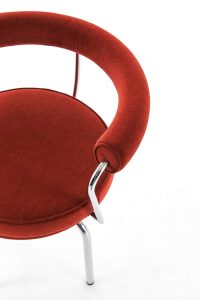
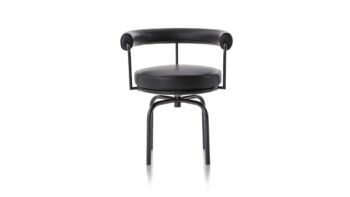
Images source:https://www.cassina.com/it/en/products/product-page.lc7.html?coatingItem=Y-Y417#007-lc7_32112
When Was the Siège Pivotant conceived?
Only two years after graduating, Perriand renovated her apartment into a room made of aluminium, glass and chrome. Then, she recreated the design of the “Bar sous le toit,” at the 1927 Salon d’Automne. Also, it shined with gleaming aluminium and nickel-plated surfaces, leather cushions and glass shelves. Moreover, at the time, the press highly praised Perriand and called her design a great success.
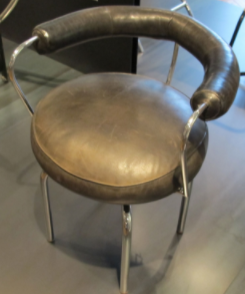
Image source: https://en.wikipedia.org/wiki/Charlotte_Perriand#/media/File:Charlotte_perriand,_sedile_ruotante,_parigi_1927.JPG
However, the designer was not finished. She wanted to work for Le Corbusier, pursue serial production and low-cost housing, but when she applied to work at Le Corbusier’s studio in 1927, he rejected her with the reply, “We don’t embroider cushions here.”
Yet a month later, Le Corbusier visited her show at the Salon d’Automne, where she exhibited the Siège Pivotant and the Bar sous le toit. After, he offered Perriand a job in furniture design and added the chair to his collection.

Image source: https://en.wikipedia.org/wiki/Charlotte_Perriand#/media/File:Charlotte-perriand-au-japon-1954-4.jpg
Siège Pivotant’s Characteristics
The revolving small armchair has a polished trivalent chrome plated enamel steel frame, that can also appear in semigloss grey, light blue, green, brown, mud, ivory and black. Further, its cushions are CFC-free polyurethane foam and polyester wadding and ermined with leather or fabric. Currently, it is available with 4 or 5 legs, and several different finishes, both for the structure and frame as well as the upholstery. Also, it is available in a waterproof and weather resistant outdoor version too.
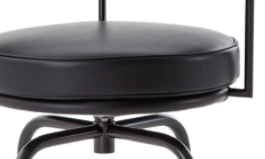
Images sources: https://www.cassina.com/en/collection/chairs/lc7
https://www.chicicat.com.au/le-corbusier-lc7-swivel-chair-platinum-replica.html
The Outdoor Version
The outdoor version of the Siège Pivotant is AISI 304 stainless steel. The internal structure and back of the seat are in pre-treated steel in an electroplating bath and finished in black. Details such as the silver welding and the use of black PVC foot ends, ensure maximum durability and reliability in all weather conditions. Additionally, the cushion insert in water draining polyurethane, makes water flow through to prevent stagnation and the accumulation of liquids, mold and unpleasant odors. Further, the back inserts are in CFC-free polyurethane foam with water-repellent coating and the fabric uses a high tenacity polyester yarn, PVC coated.
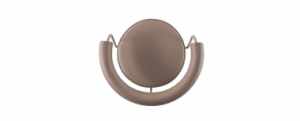
Image source: https://www.cassina.com/it/en/products/lc7.html?coatingItem=Y-Y417#007-lc7_32112
Data Sheet
- Designer: Charlotte Perriand;
- Year of design: 1927;
- Year of production: 1978;
- Manufacturer: Cassina.
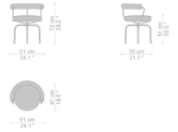
Image source: https://www.cassina.com/it/en/products/lc7.html?coatingItem=Y-Y417#007-lc7_32112
Info sources:
https://www.cassina.com/en/collection/chairs/lc7
https://cs3cdn.haworth.com/sites/cassina.com/files/lc50_brochure_22.pdf
https://cs2cdn.haworth.com/sites/cassina.com/files/product-sheets/lc7_singole.pdf
